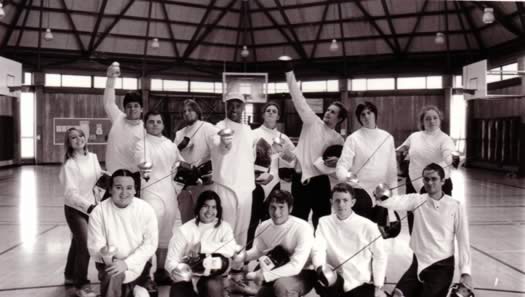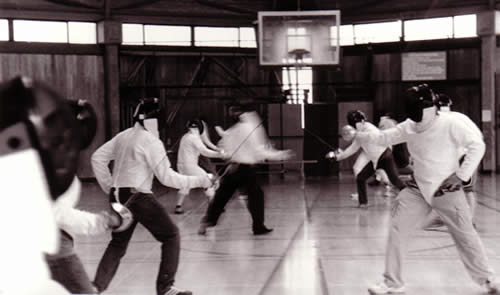Fencing Saber

In making touches to the chest and
the left cheek of the opponent, the blade is extended slightly
beyond the target, and, in executing the cut, the blade is pulled
back across the target.
In making cuts to the top of the head, to the right cheek, to
the flank or to the arm, the blade makes a short forward cut on
the target, executed with a snap of the wrist. This snap, however,
must not take the blade more than an inch or two away from the
target. Both in cutting and thrusting, the arm is completely extended
at the finish, unless the the distance should happen to be so close
that the opponent can be reached without a full extension of the
arm.
HEAD CUT
From an engagement in the Third Guard the hand is turned presented
to head and simultaneously the arm is extended completely.
The lunge is begun immediately after the extension has been started.
Immediately after the blade makes contact with the head, the right
foot lands in the lunge. The actual cut is made on the top of the
mask with a forward snap of the wrist. This snap, however, must
not take the blade more than an inch or two away from the target.
Nor should it remain pressed against the mask. In making the cut
to the head, there must always be an angle between the saber and
the forearm, hand at right shoulder height, in order to protect
the forearm with the guard of the weapon.
FLANK CUT
From an engagement in the Third Guard, the hand is turned presented
to flank. The arm is extended and the blade is moved forward, clearing
the opponent's guard as close as possible to his forearm. The lunge
is begun immediately after the extension has been started. Immediately
after the blade makes contact with the flank, the right foot lands
in the lunge. The cut to the flank is made an instant before the
right foot reaches the floor in the lunge and is made with a forward
slicing motion. Return to Third Guard.
CHEST CUT
From an engagement in the Fourth Guard the hand is presented
to chest and the arm is extended completely. The lunge is begun
immediately after the extension has been started. Immediately after
the blade makes contact with the chest, the right foot lands in
the lunge. Draw the blade back across the chest to the left in
a diagonally downward movement. The touch always is made as a light
tap and the blade is drawn across the chest in a backward slicing
motion. The slice is started before the right foot begins the recovery
to the Third Guard.
CHEEK CUTS
A cut to the RIGHT CHEEK is made in the manner of a cut to the
flank, except that the saber is held higher (the hand at cheek
height) and the blade is kept in a horizontal position. A cut to
the LEFT CHEEK is executed in the same manner as a cut to the chest,
i.e., in a downward diagonal direction, but with the hand held
higher (at cheek height).
ARM CUTS
These cuts, when made on the under part of the arm or the outside
of the arm, are made in the manner of flank cuts; a cut to the
arm as a head cut; and on the inside of the arm, either in the
same direction as a chest cut, or, they may be made with the blade
and arm forming about 150 degree ? and with the use of the wrist
and slight use of the forearm.
ATTACKS
A successful attack in saber fencing consists of a cut or thrust
landing on the target in such a manner as, in an actual duel, with
either edge of the blade, would draw blood; or, as a thrust, it
would cause a punctured wound. Touches made with the flat side
of the blade, according to the rules, are not valid, although it
is very difficult in some cases to distinguish between a touch
made with the edge, half flat or flat.
There are two kinds of attacks, Simple and Compound:
A SIMPLE attack consists of one movement; whereas COMPOUND attacks
are made in two or more movements.
SIMPLE ATTACKS
A Simple attack may be made as a direct or indirect movement
either from an engaged position or when the two blades are not
in contact. The following are examples:
From an engaged position. Both opponents in Third Guard, the
defender fully covered with a complete Third, giving an invitation
for attack. The attacker may make the following:
(a) disengage thrust
(b) direct cut to flank under the hand
(c) Cutover to the head
(d) Cutover thrust
(e) Cutover to the chest
From an engaged position. Both opponents in Third Guard but with
neither one taking a complete Third, i.e., one which would protect
the right side. The following forms of attack maybe made:
(a) direct thrust with a glide
(b) direct cut to head
(c) " " " forearm
or upper arm
(d) " " " right
cheek
(e) disengage thrust
(f) direct cut to flank
(g) cutover thrust
(h) Cutover chest cut
When the two blades are NOT IN CONTACT. For instance, the attacker
is in Fourth and the defender in Second. The blades not being engaged,
all simple attacks will be made as direct movements. The attacker,
from Fourth, may make the following:
(a) Thrust
(b) Cut to the arm
(c) Cut to right cheek
(d) Cut to the head
(e) Cut to the chest
Reverse the preceding example, and the attacker, from Second,
may make the following:
(a) Thrust
(b) Cut to the arm
(c) Cut to right cheek
(d) Cut to head
(e) Cut to flank under arm
In addition to the above examples, it will be necessary to practice
simple attacks from all possible positions. These simple attacks
should be made to all parts of the defender's target except, of
course, to the one which is closed by this Guard Position.
EXECUTION OF SIMPLE ATTACKS
DIRECT CUT---The direct cut is a forward movement in the same
line, with or without a lunge according to the distance, and finishes
as a cutting movement with the edge of the blade.
DIRECT THRUST---In saber the thrust is always made with the hand
in pronation.
CUTOVER CUT or CUTOVER THRUST---The cutover is a simple attack
made in the opposite side of, and above, the opponent's blade.
It is not made with the forearm alone, but also with the assistance
of the wrist, which, as in all actions, is locked in the moment
of completion.
DISENGAGE THRUST--the disengage thrust is made in the same way
as the foil thrust, except that the hand is always in pronation.
DISENGAGE CUT--Is made on the opposite side of the opponent's
blade by moving the attacking blade either above the point of the
opponent's blade or under the hand.
FEINTS
In saber fencing, both cuts and thrusts can be used as feints
by merely presenting into the line you wish your opponent to close.
COMPOUND ATTACKS
Compound attacks consist of two or more movements, and the touch
may be made as a cut or or thrust.
REPLACEMENTS, REDOUBLES, and RENEWALS OF ATTACK
Replacements, Redoubles and Renewals of Attacks may all be made
as cuts or thrusts.
COUNTER ATTACKS
Counter attacks may be made
as: TIME cuts or TIME thrusts; and as STOP cuts or STOP thrusts.
It is most essential after each time cut, however, whether it
lands or not, that a parry be taken immediately, covering the
threatened target so that even if the time cut failed, a parry
and riposte may save the situation. It is advisable to make a
leap backward with a parrying motion after the time cut has been
made (by placing the right foot close behind the left one, bringing
the left foot back and finishing the backward leap in the normal "On Guard" position).
Time cuts against simple attacks are too risky, unless the attack
is slow. They may land in the same moment as the attack, in which
case the touch is given for the attacker who has the right of way.
Thus the stop cut parry riposte, unlike the time cut is less risky
however much practice is require to attain success
PARRIES
The Guard Positions described previously are identically the
same as the final positions of the Parries. It is understood, of
course, that the guards are still positions whereas the parries
are actions, the defender moving his blade from one position to
another.
CEDING PARRY
The CEDING PARRY may be used against straight thrusts made with
glides by letting the blade be carried to a parrying position by
the force of the attacking blade, instead of resisting the attack
in the original position.
For instance, when a thrust is made with a glide in second, the
saber is led to the Fourth Parry; or, when a thrust is made with
a glide in Third, the saber is led to the First Parry.
FLYING PARRY
The FLYING PARRY may be used
as "Parry of First and Riposte
to the Head," in one continuous movement without halting even
for an instant in the parry.
COUNTER PARRY
The COUNTER PARRY is made with the wrist and a slight use of
the forearm, the point of the saber describing a complete circle
around the opponent's blade. The wrist must lock just before meeting
the opponent's blade. The wrist must lock just before meeting the
opponent's blade. This counter or circular parry is used against
thrusts only.
RIPOSTES
The RIPOSTE (Return) may be made as a cut or thrust, executed
after a parry, with or without a lunge, in reply to an attack.
TIMING
When two fencers are of equal
experience, it will be almost impossible for either to score
an attack, unless the opponent is completely surprised by the
action, i.e., unless the attack is made "in
time." On the other hand, when an attack is made in time,
in the correct distance and with maximum speed, the probability
of bringing this attack to a successful finish is 99%.
A fencer is always alert in a bout. However, it is impossible
to maintain the same degree of alertness throughout the bout, it
rises and declines. Therefore, it is obvious that when an attack
is made at the peak of alertness, the adversary will be most ready
to parry or make a counter attack. Once his alertness begins to
decline, the attack will have a good chance.
Thus, theoretically, it is easy to understand when to attack.
In practice, however, this is the most difficult problem of a fencer.
We may speak of two kinds of timing: Conscious, and Subconscious
timing.
(a) Conscious Timing is the tempo chosen when the opponent is
in some kind of motion. Successful attacks may be launched while
the opponent is doing any of the following unconsciously:
Standing up or sinking in the On Guard Position. Making on advance.
Making a retreat. Recovering from a lunge. Making a feint without
the intention of attacking. Returning from same. Engaging the opponent's
blade. Disengaging the opponent's blade. Beat or any other action
against blade without the intention of attacking. Going from one
guard position to another (invitation).
Any motion of the whole body or part of it requires some effort
and attention on the part of the fencer and whatever amount of
attention is used for the execution of these movements, it detracts
from his full concentration on the bout.
The fore-mentioned examples
cannot always be accepted as opportunities for attack as the
opponent may offer them deliberately as a "false
tempo" to invite an attack which then would be met with a
well prepared Parry and Riposte.
(b) Subconscious timing is that
used when a fencer chooses a moment to attack suggested by his
instinct.
